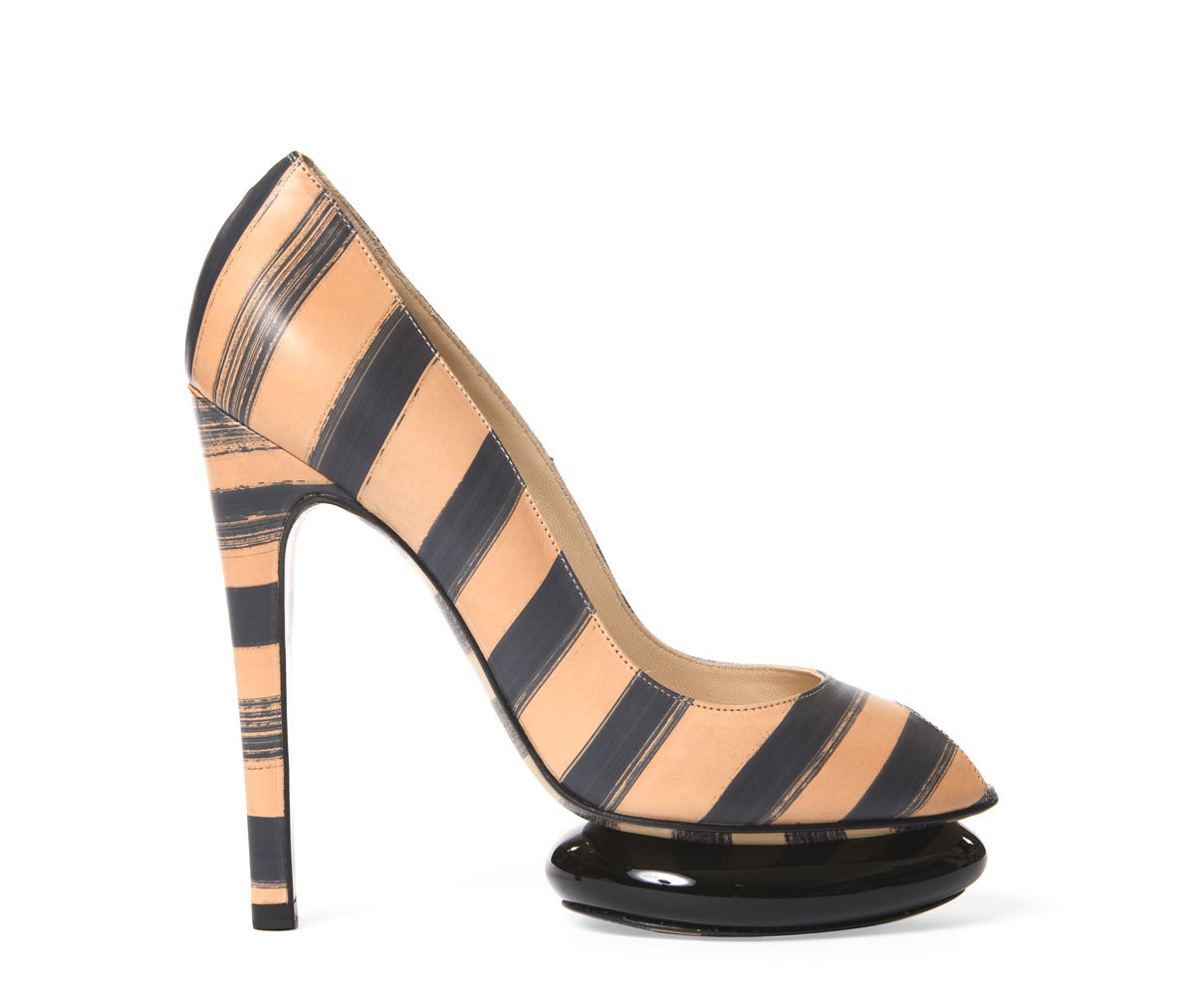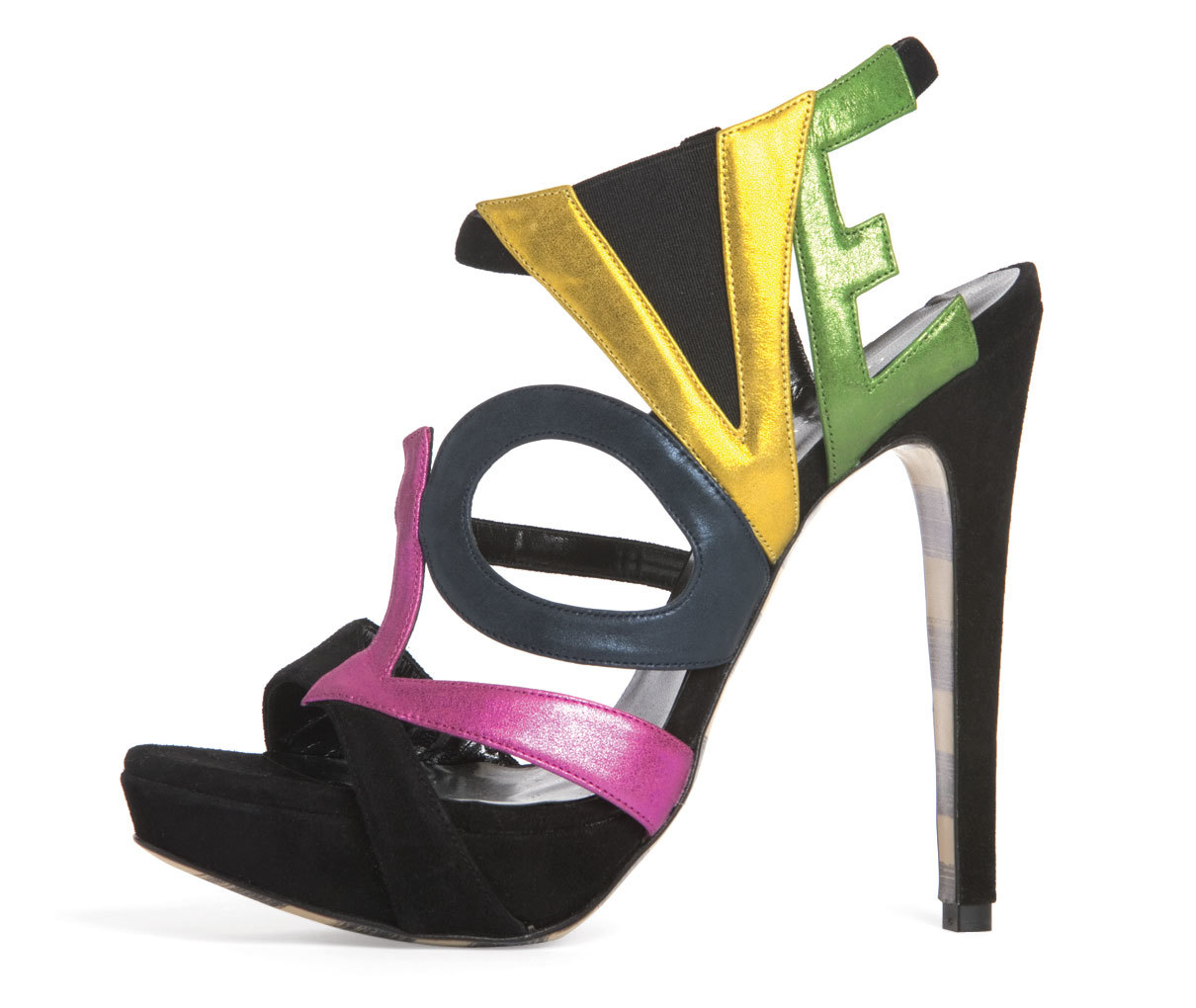Georgina Goodman’s latest collection A Shoe Story, comes 15 years after her first foray into footwear design. Comprising a range of signature stripe, hand-painted leather slip-ons inspired by the traditional Babouche for spring/summer 16, this simple ensemble announces afresh her relationship with fashion. Streamlined and lean, just like Goodman herself, the latest creations embody a unisex utilitarianism but there’s exotica and artistry too.
Goodman works with a very small team in her west London studio, an operation pared-down for a reason. Hers is an epic tale of beauty, magic and treachery, and in a fashion climate where young creatives are propelled to set up their own label as ultimate proof of talent, her testament can shine light on a shadowy path.
So let’s go back to the point in the narrative where our heroine runs a highly successful and eponymous shoe design label whilst simultaneously holding a six-season consultancy for McQueen – a collaboration, which delivers the iconic Armadillo shoe and sees her continuing to work alongside Sarah Burton after McQueen’s untimely death.
With a business boasting two Georgina Goodman stores, one in Mayfair and the other on Old Bond Street, her designs stocked by the best high-end fashion stores worldwide, a flourishing online e-commerce site, 17 staff and a variety of consultancy projects grown over 10 years of careful stewardship, she is now ready for the next phase: ‘Growth Capital’ from carefully sourced professional investors.
“From the very start, after I left RCA I wanted a department store – a Georgina Goodman World. It began with shoes, which were not just decorated uppers they came with intent,” she remembers.
The vision became real with premises in Mayfair’s then red light district – Shepherd Market. An old photocopy shopwas refurbished to become a gallery store. The basement studio was fitted with a glass ceiling so customers, once in the store, could view Georgina herself cobbling on-site below. Showcasing made-to-order shoes cut from a revolutionary single pattern-piece alongside soft furnishings, art and hand luggage – the journey towards a charming purpose was begun.
“You have to be quite egotistical to put your name to a product. We designers use our egos in a positive way by making a projection of ourselves so that others can buy into our taste. Of course other egoscan come and fuck you up too,” she says mischievously, signalling trouble ahead in this story.
Meanwhile, generous patrons and mentors are an important part of any good yarn and Goodman is not short of those.

“I delivered projects for Manolo Blahnik as an RCA student on the brilliant course run by Sue Saunders and won a prize from him. After graduating and on the verge of announcing my new label, I attended his private view at the Design Museum. As I entered, he immediately turned heads my way. ‘Darling, how lovely to see you, thanks for coming.'” She mimics his well-known, yet unplaceable accent and with a grand gesture of the hand continues… “he bellowed to everyone in the room, ‘Don’t look at me, look at her. She is the future.’ Every journalist interested in shoes was there that night and my career was launched.” We laugh… it’s the stuff of films and fairy tales.
“Manolo was the very first person to ring my new business and give me generous encouragement. He became a mentor, he gave great advice…he was funny too…’horrible platforms,’ he would say…’Darling don’t do horrible platforms.'”
A light sprinkling of fairy dust is ever present… and the very first customer told all her glamourous friends about Goodman’s made to order shoe service. Jerry Hall was a big fan. Then in a rare endorsement, Vogue featured her spring/summer 04 designs on their front cover. With husband BJ at the sharp end of the business a total of 54 stockists were recruited after two seasons of the Ready-to-Wear launch, those first few years of business delivered excitement beyond dreams. So far, soooo fashion darling!
“You have to be careful what you wish for,” warns Goodman. “The task of building my brand simply devoured cash. Everything I earned from consultancies and runway show collaborations went straight back into the business. Each time we moved up and took new orders, new funds were required. We had to finance the orders upfront and we were paid 6-12 months later. You can become a victim of your own success, so much so that you can’t afford to fuel the organisation you have created. It was never easy but banks stopped lending after the Lehman Brothers fiasco. What was once simple trade finance had to be afforded with equity. That’s why venture capital money becomes necessary.”
With good reason, when the business won its sophisticated investor and a board of professional Directors, the husband and wife team allowed themselves to celebrate. But within a year, the story would take a shocking turn and see staff standing by helplessly as a team of operatives in boiler suits carried out a legal raid on all premises simultaneously. The studio and stores were stripped of every asset. Georgina was stripped of her name.
Goodman takes up the account. “First they got rid of BJ, as he was my team-mate and supporter, it was devastating. Then they demanded I change my aesthetic to appeal in a more targeted way to the Middle East markets. Then they started looking away from Europe for production, thinking only of margin” Goodman’s look had a pared down sensibility with wood, leather, monochrome and bright graphic elements to project a contemporary modernity. The investors thought it should all be about spangles and glitter. Instant profits were expected and obedience was demanded.
“Concept development is very costly and that isn’t the part of a design business that makes the money, it’s the mass-market spin offs: perfume, hosiery, glasses etc. As conflict escalated, I was portrayed as obstructive because I had a design and quality vision that was contrary to theirs. At the end of my tether and in and out of board meetings (towards the end I did 17 in two weeks) there was no time to be productive or creative, then my investors brought in lawyers – it’s called a pre-pack administration.”

“On the day that they dismantled my business, I threw my body across my possessions and fought to keep my life intact. They were taking things while I was holding on to them. They took my drawings, my designs…anything that was on a shelf was swept into a box. It was a brutal ransacking. It felt like theft. These were people I had sat in a board meeting with yet the next moment they were stripping my life down to the bone and taking my name.”
This revolting assault has happened to many in fashion as the corporate machine dictates terms and the suits hide behind company law. Goodman references the alternative ‘lifestyle business,’ where an enterprise grows slowly. “It’s one way, but the ugly truth is that fashion simply isn’t interested in something slow.” Journalists want new stories; stores want press and excitement to follow any designer they stock, and without investment to create a bigger splash each season, it’s hard to keep buyers interested.
“The fashion industry doesn’t actually work for designers,” states Goodman with clarity. “I love what I do but the infrastructure and logistics are hard and costly. We had a beautiful gallery space with shoes that were art pieces but I couldn’t hand-make, quick enough. The next step: a Ready To Wear collection of samples, exhibiting round the world with the upfront cost of development, materials and manufacture against future orders and payment, sets up immediate cash-flow problems. Banks don’t lend against orders and the costs of creating the sample collection alone involve more than 100,000 euros per season. This is before you even start to add overheads, marketing and administration, let alone retrieve any outlays.” It’s the bank threats and incessant pressure during the horrible wait for money to flow that will come as a shock to young creatives looking at the business model through rose-tinted glasses. And without adequate capital to trade, it’s a system that presses them into the arms of Venture Capitalist. This is not a guaranteed happy ever after outcome.
“I focused on creativity while my husband BJ drove the business. He was fearless around money, while I’m very cautious. I made the beauty, and he tamed the beast for 10 years,” she smiles. “I would be kicking and screaming about the insecurity of borrowing against our house, while he absorbed all the stress. With hindsight of course that exhausted us both.” Surviving in a fashion business with, or without backers takes its toll on relationships too.
Now separated but supportive of each other, a new dawn begins. BJ and Georgina bought her name back a short while ago (2014) and she now operates on her own terms. Early sales for the new collection are good. “Ideas are never a problem. I can draw 50 designs in a day…I can access a seam inside me. My creative process is very similar to most. I start off by saying I can’t do it, I’m awful, I’m shit but then I sit down and force myself to begin. I work through the tiredness and keep on going down until I can find ‘IT.’ When I get there I love it.”
These days Goodman is driven by the same tireless passion to create. Now coupled with the wisdom of her experience, she treasurers ideas and innovation and will be one of the speakers on 20th November for the Shoe Culture and Innovation Symposium at the V&A. Of course she will delight audiences with her stories of McQueen – whose other-worldly creativity pushed her harder than she had ever been pushed. And, as a natural comedian, she will get some laughs too.
As we come to the end of one chapter, Goodman outlines her plans for the next. An exquisite prototype couture design sits on her desk featuring peacock feather fronds woven through embroidered and beaded lace, embedded with insect wings, this shoe is just one of many in a new collection being developed. With an existing site for new product and treasured archive sales, georginagoodman.com she will also launch her ‘pre-tail concept,’ and complimentary website later in the year. Introducing a new pre-ordering culture (to cut down on wasted stock and materials – as everything in production is already commissioned) is an important shift for this cobbler.
A happy ending? No. More like a phoenix from the ashes. Georgina Goodman’s shoe story is on-going. It’s also a survivor’s message for all young creatives starting out. While similar stories of artistic integrity battling commercial exploitation unfold from the camp of Lanvin, we can recognise that the David and Goliath analogy throws up conflict ripe for challenge. Embodying our ‘own,’ idea of success is one route to personal equilibrium. Raf Simons called time on his Dior contract and unlike his predecessor stepped away early… with mental health intact. The speeding up of fashion and ideas, the spitting out of creatives who don’t deliver to a quarterly profit review or who stand firm behind their creative vision – these are sustainability and business innovation issues too.
A sustainable business, a smoother ride and balanced operation – these things are a mission. And a business model that honours design and craft and customer and quality in the long-term, as well as looking after people before short-term profit; these are the goals Georgina Goodman has written into her new process. She is an important chronicler of our times and presides over the next phase of her creativity as master of her own script. Read on.
vam.ac.uk/shoes-culture-and-innovation
Credits
Text Caryn Franklin
